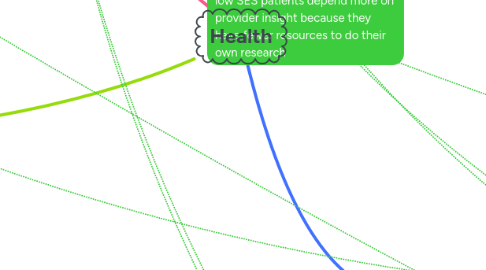
1. Definitions of Health
1.1. Biopsychosocial Definition:
1.1.1. Biology
1.1.2. Psychology
1.1.3. Social Factors
1.2. Biomedical Definition: healthy is what you are if you do not have a disease/illness/ailment that a medical professional can treat
1.3. Ability to complete one's social roles
2. Social Effects of Health
2.1. Health Disparities
2.2. Inability to complete one's social role
2.3. Education Gap
2.4. Reintroduction of Disease
2.5. Inability for all members of society to use public services/facilities
2.6. Social Roles/Relationships
2.6.1. Doctor
2.6.1.1. Verstehen: taking on the role of the other
2.6.2. Patient
2.6.2.1. Sick Role: a social role characterized by certain exemptions, rights, and obligations, and shaped by the society, groups, and cultural tradition to which the sick person belongs
2.6.3. Parent
2.6.3.1. Demographic of a parent that does not follow vaccination schedule
2.6.3.1.1. Mother
2.6.3.1.2. White
2.6.3.1.3. Educated
2.6.3.1.4. High Income
3. Three basic models of physician-patient relationships
3.1. Activity-passivity model showcases the physician doing something to the patient and the patient receiving it without any collaboration
3.2. Guidance-cooperation model includes the physician telling the patient what to do and the patient cooperating
3.3. Mutual participation showcases the physician helping the patient to help himself and the patient participates in the partnership
4. Factors that Impact Provider-Patient Interactions
5. Social Causes of Health
5.1. Lifestyle/Behaviors
5.1.1. Smoking
5.1.2. Why do People Engage in Behaviors?
5.1.2.1. Values (behavior is done because the individual believes it is the right thing to do)
5.1.2.2. Instrumental (behavior is completed because the actor believes it will lead to an outcome they want)
5.1.2.3. Affect (behavior is done because of an emotion felt by the actor)
5.1.2.4. Tradition (behavior is done because it is the typical behavior)
5.1.3. Vaccination
5.1.3.1. Vaccination is a social norm
5.1.3.1.1. Weber's Definition of Crime: violation of a social norm
5.1.3.1.2. Durkheim's Definition of Crime: crime, punishment, and public outrage/disgust are related triangularly
5.1.3.2. Risk of Vaccination/Not being vaccinated
5.1.3.2.1. fatalism: the belief that all events are predetermined and therefore inevitable.
5.1.3.3. Trust or Distrust of institutions involved in vaccination
5.1.3.4. Solidarity
5.1.3.4.1. egoism: an ethical theory that treats self-interest as the foundation of morality.
5.1.3.4.2. anomie: lack of the usual social or ethical standards in an individual or group.
5.1.3.5. Religious Beliefs
5.1.3.6. Expertise
5.1.3.6.1. Doctor expert of medicine
5.1.3.6.2. Parent expert of child
5.1.3.7. Individualism
5.1.4. Wearing/not wearing a bike helmet
5.1.4.1. helmets don’t create safety, laws that promote bike safety create safety
5.1.4.1.1. Helmets have historically been a way of deflecting the bicycle safety issue from the government to individuals. The best way to improve the safety of cyclists would be for the government to invest in biking infrastructure.
5.2. Clinical Healthcare
5.2.1. Cost
5.2.1.1. Cost includes both the amount individuals pay for their healthcare and the amount a nation spends on healthcare. The United States spends significantly more than other countries on healthcare.
5.2.2. Access
5.2.2.1. Access deals with a person’s ability to obtain necessary, affordable, convenient, and effective care in a timely manner. This is a major problem in the US.
5.2.3. Quality
5.2.3.1. The quality of healthcare in the United States tends to be considered very good. However, the measurements of quality healthcare, infant mortality and life expectancy, say otherwise
5.2.4. Healthcare Models
5.2.4.1. The mutual aid model includes members regularly contributing small amounts of money and local councils administering funds and services. These funds help provide money to those who become ill or to their families if they die.
5.2.4.2. The state model includes governments developing national healthcare insurance programs with the goal of protecting the interest of the state or larger society. Depending on the organization of the government, it can be more centralized or localized.
5.2.4.3. The professional model puts medical professionals at the center of healthcare financing, regulation, and service provision. These professionals leverage their expertise, citing the need for professional autonomy, especially in clinical decision-making, to provide the best care for patients.
5.2.4.4. The corporatist model is a structured counterbalancing of the conflicting priorities and values of citizens/consumers, providers, and payers.
5.2.4.4.1. closest to what US offers. US does not have a true healthcare system. It has tried at times to implement closer to universal health insurance (Obama care).
5.3. Socially Constructed Environment
5.3.1. Walkable/bikeable cities
5.3.1.1. Reduced obesity
5.3.2. Urban Noise
5.3.2.1. Cars cause a lot of noise pollution, especially because people driving the car can’t hear it from inside the car. Though urban noise has been normalized, it can be significantly reduced.
5.3.2.1.1. Negative health consequences including hearing loss, cardiovascular disease, type 2 diabetes, sleep disturbance, stress, mental health problems, etc
5.3.3. Large temperature between neighborhoods (even when they are close together) based on red-lining (residential segregation)
5.3.3.1. Negative health consequences due to intense heat. Potentially death.
5.3.3.1.1. varying the heights of buildings to promote air flow
5.3.3.1.2. include green spaces in urban areas
5.3.3.1.3. plant trees to provide shade
5.4. Public Health Care
5.5. Social Determinants of Health
5.5.1. **Socioeconomic Status**
5.5.1.1. Class
5.5.1.1.1. Income
5.5.1.1.2. Wealth
5.5.1.2. Education
5.5.1.3. Social Status
5.5.2. Race
5.5.2.1. Race
5.5.2.2. Ethnicity
5.5.3. Religion
5.5.4. Gender
5.5.5. Geographic Location
5.5.6. Age/Cohort
6. Social Contexts of Health
6.1. Education
6.2. Government
6.3. Science/Technology/Industry
6.4. SES
7. Parts and Dimensions of Health
7.1. Individual Health
7.2. Group Health
7.3. Population Health
7.3.1. Rates: percentage of population experiencing M&M
7.3.2. Incidence: how many new cases
7.4. Levels of Analysis
7.4.1. Global: Humanity
7.4.2. Macro: society
7.4.3. Meso: cooperations, doctors' offices, etc
7.4.4. Micro: friends, family, coworkers
7.4.5. Individual: person
7.5. Morbidity and Mortality
7.5.1. Maternal Mortality Rate
7.5.2. Infant Mortality Rate
7.5.3. Life Span
